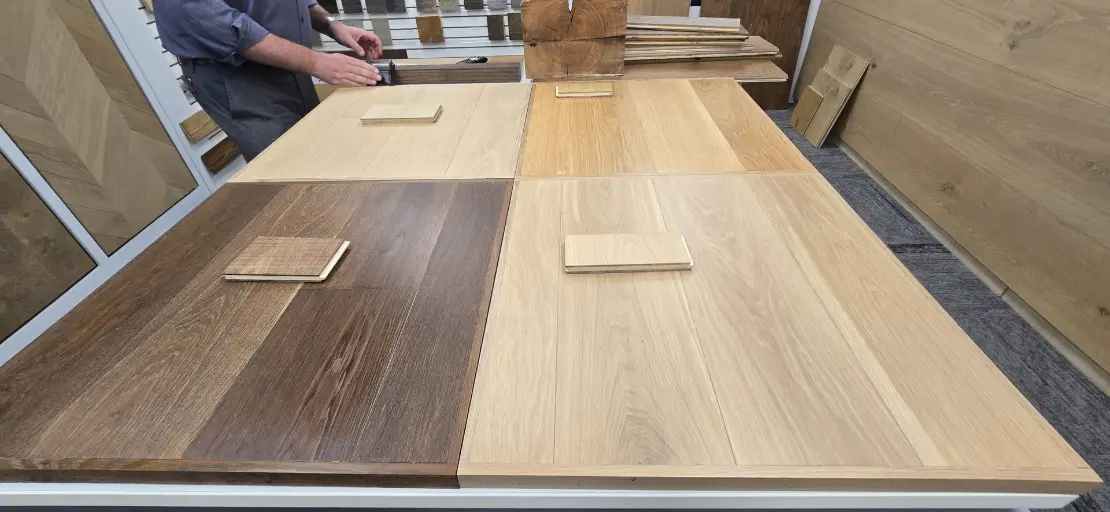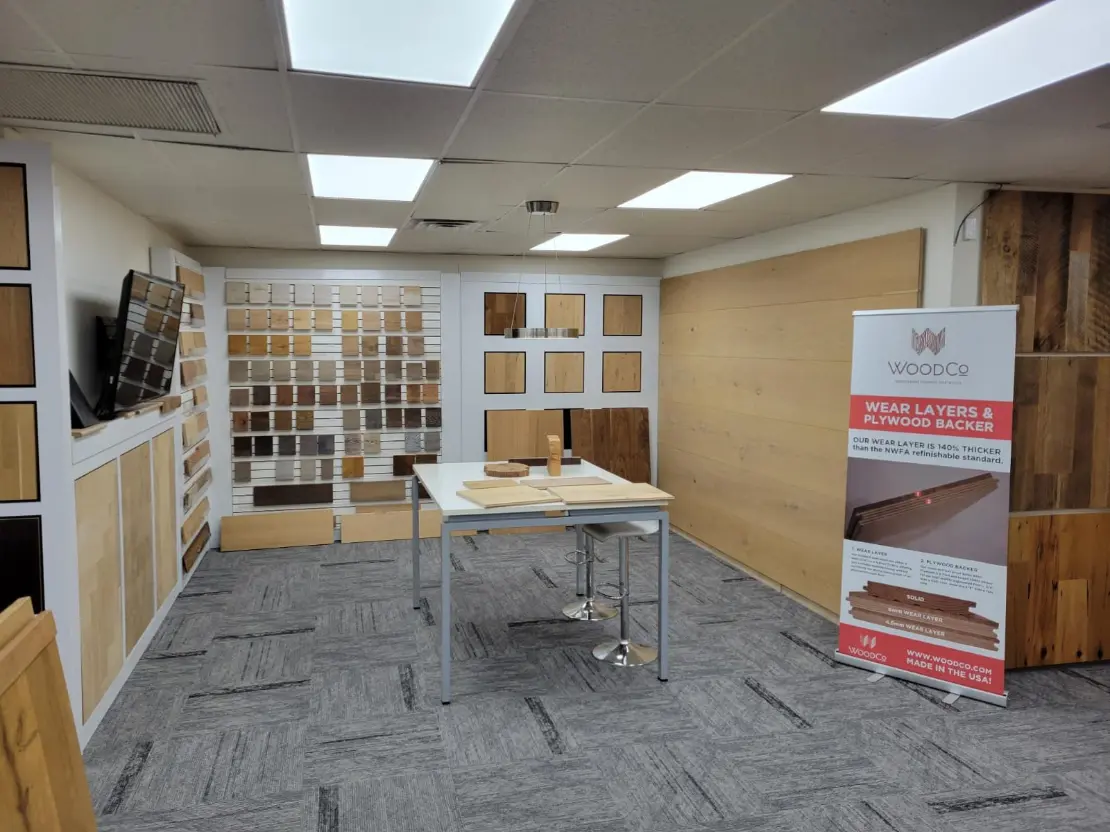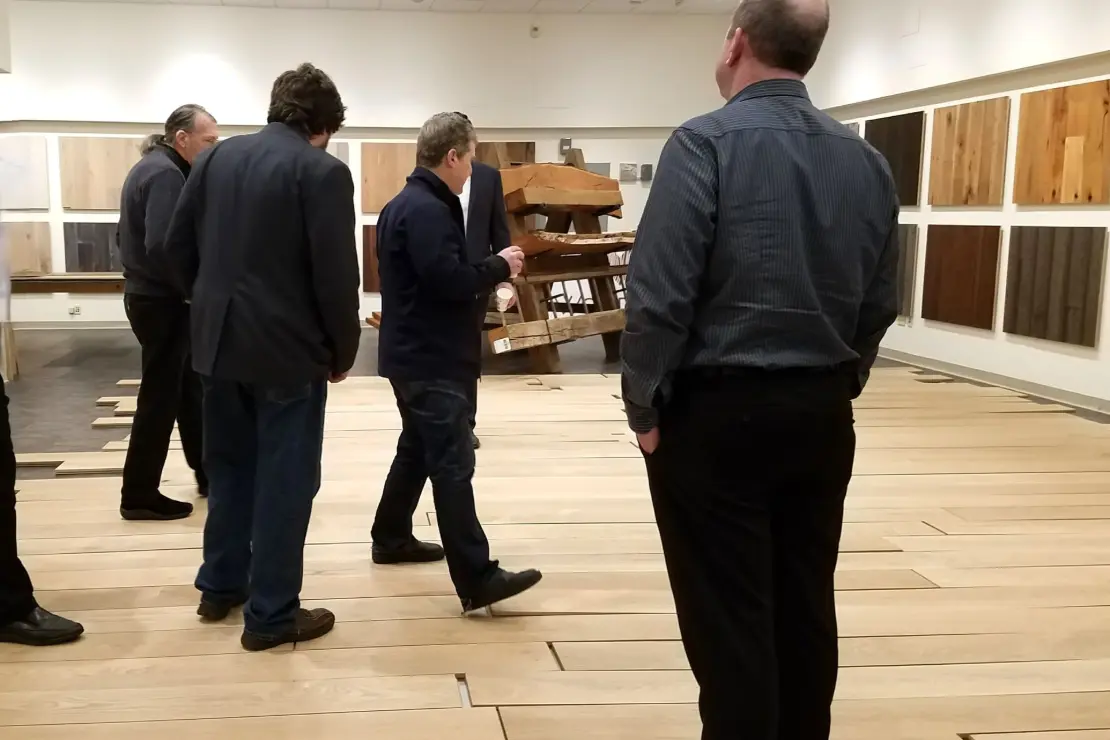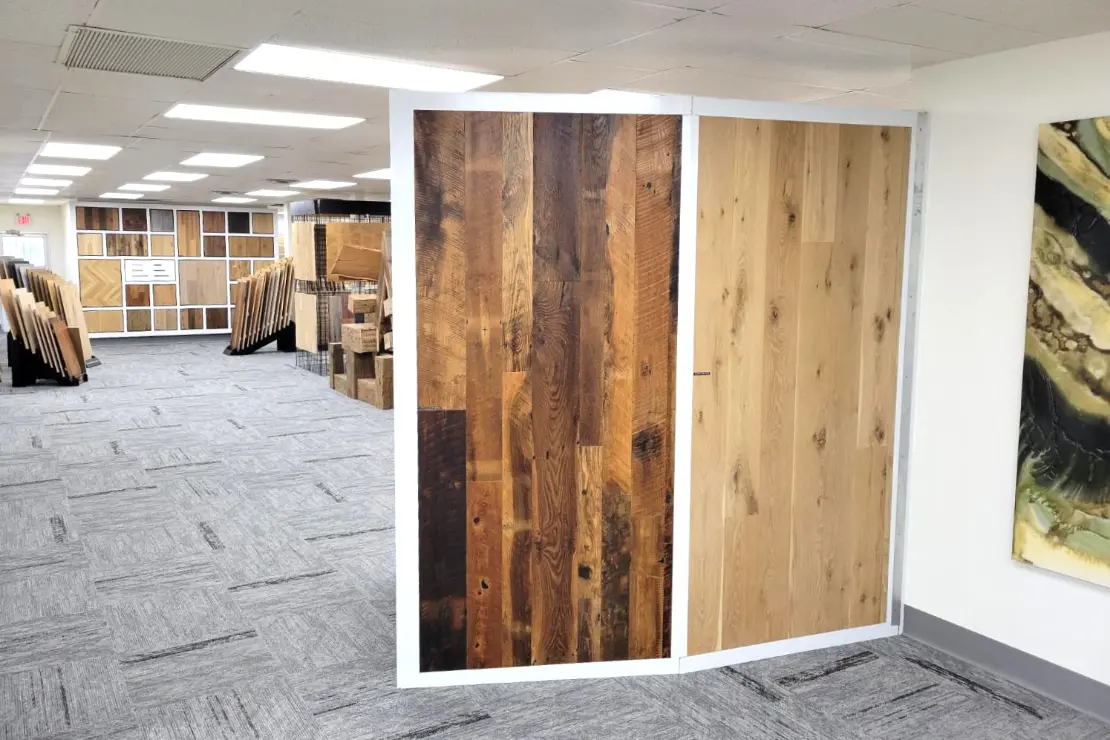Design professionals rely on strong partners to bring their ideas to life, especially when it comes to choosing and finishing the wood that grounds an entire room. For many projects, the floor acts like a piece of built-in furniture, anchoring the space and setting the tone for everything that follows.
From private homes to landmark public spaces, architects and designers turn to WoodCo for the craft, guidance, and custom solutions that make ambitious work possible.
This is a look inside how we work side by side with design teams: how we help refine choices, solve technical challenges, and make sure every detail supports the bigger vision.
The Creative Corner: Visit Our San Antonio Wood Flooring Showroom
Inside our San Antonio showroom, the Creative Corner is where designers, architects, and their clients gather ideas and test choices in person. No appointment is needed, though many prefer to plan time with our wood specialists.
Around this space, our team of experts is always ready to answer questions and refine details that bring a design together.
The Custom Wood Flooring Selection Process
1. Choose Your Species
Oak, walnut, hickory, or a reclaimed option for heritage work. Each species sets the tone for the entire room.
2. Select the Grade
Clean, rustic, or a balance in between. Not every species supports every grade, so our team guides each choice to match the vision and the material’s best qualities.
3. Define the Milling
Plank width, board length, herringbone or other patterns, plus edge profiles such as micro bevels or rolled edges. These details shape how the floor reads in a finished space.

4. Decide on Construction
Solid or engineered – depending on climate, room placement, and project performance needs. Coastal humidity, basement conditions, or dry climates like Arizona all play a role in this choice. Our experts guide you through it.
5. Add Texture
From circular saw marks, to hand-scraped finishes, and wire brushing, texture shifts the surface from smooth and contemporary to characterful and timeworn.
6. Finalize the Finish
The final layer – color treatments, durable finishes, and the chosen sheen – locks in the tone and ensures the floor’s look matures gracefully with daily life.
Every step is shaped to ensure the wood works for the space and holds up beautifully for years to come.

Wood Flooring Samples & Mock-Ups
Our sampling process makes choices tangible. Once options are discussed and quoted, we create samples that show true color, finish, and character. For most requests, samples are ready in one to three weeks – always produced with care to match the vision precisely.
Some projects start with a photo pulled from Pinterest. Others arrive with a single plank from a century-old floor, needing an exact match. Our team knows how to read the signs in the grain, guide adjustments, and create panels that make the decision clear.
We build our samples to reflect reality – three boards, 18 inches long, showing natural variation so clients understand how the floor will perform at scale. For large or complex projects, we produce custom panels that help specifiers secure client approval and move confidently toward production.
Custom Millwork & Unique Wood Flooring Solutions
When a design calls for a detail that can’t come off the shelf, WoodCo’s mill and technical team find a way to make it work. Some projects demand it, and that’s where our experience stands out.

At the Clark Art Institute, for example, stair treads needed to meet strict safety standards while staying true to a refined interior scheme. We produced combined treads and risers with integrated metal strips and cork buffers to protect surrounding glass panels, all milled to install cleanly on site.
For the Museum of Modern Art in New York, we supplied super select white oak planks – longer, wider, and thicker than standard – with strict limits on knots and sap to keep the galleries quiet and uniform.

Boards were milled in multiple widths so the floor could align perfectly with structural columns throughout the building. Even delivery took planning: every load was staged in smaller vans and timed for off-peak hours to reach the downtown site with zero disruption.
Our experience also makes a difference for historic restorations. Often, homeowners or designers arrive with a worn piece of floor, unsure of its exact species or origin.
Our team can identify, match, and recreate wood that blends new construction with original materials, right down to milling profiles, stair parts, or trims that tie the story together.
Technical Support for Architects & Designers
Design decisions often raise practical questions. Which materials will hold up best in this climate? How should a floor be finished for a busy retail space or a quiet private home? What adjustments help a historic restoration meet today’s standards without losing its character?
We hear these questions every day. Our role is to give clear answers that make the path forward simple – from choosing species and grades to advising on finishes, installation, and long-term performance. With deep product knowledge and real-world experience, our team helps keep projects moving, with no detail left to chance.
Frequently Asked Questions: Custom Wood Flooring for Architects
Should I choose solid or engineered wood flooring?
Solid wood flooring is timeless and can be refinished many times, but reacts more to humidity. Engineered wood flooring is more stable for basements or concrete subfloors and installs faster. We guide you to the right choice for your climate, budget, and design vision.
What’s the difference between unfinished and prefinished wood flooring?
Unfinished floors are sanded and stained on site, ideal for creating a fully custom finish but they require skill and create dust and fumes. Prefinished boards are finished at the mill for a consistent, durable surface with a microbevel edge that makes installation cleaner and faster. We guide you through which makes sense for your design and schedule.
Can you match existing wood for historic renovations?
Yes. Many clients bring us an old plank or a sample they can’t identify. Our team can match species, grain, grade, and finish, and we can mill stair parts or trim to tie the old and new together seamlessly.
Can WoodCo produce custom stair parts and millwork?
Absolutely. From custom stair treads and risers to trims and unique profiles, we manufacture millwork that matches your flooring exactly, whether you want it finished at our mill or unfinished for site finishing.
How does WoodCo handle complex or custom project requirements?
We specialize in custom work that off-the-shelf suppliers can’t handle. For projects like MoMA or the Clark Art Museum, we solved technical challenges with unique milling, integrated safety features, and precise installation guidance, so ambitious designs come to life exactly as intended.
Do you provide CAD files and spec sheets for architects?
Yes, we make it easy for architects and designers to download CAD files, installation guidelines, and detailed specs, so you can drop products straight into your plans with confidence.
How long does it take to get custom samples?
Most samples are ready in one to three weeks. Each one shows real color, grain, and character so you and your client can sign off with no surprises later.
How do I know which wood species or grade is right for my project?
Our specialists help you balance performance and appearance. From wide plank white oak to reclaimed walnut, we explain which species, grade, and milling details fit your project’s look, budget, and technical needs.
Start Your Custom Wood Flooring Project
The best results come from early conversations and careful planning. Whether you’re matching a century-old plank, sourcing reclaimed material for a heritage site, or specifying a new pattern for a flagship project, our team is ready to help shape the next step.
Book a consultation, bring your samples and ideas, and see what’s possible when craft, service, and design expertise come together.



